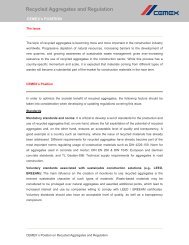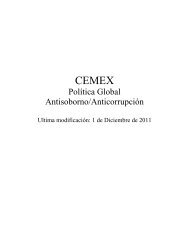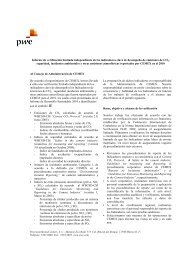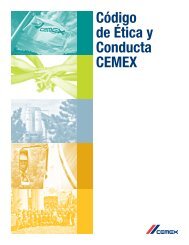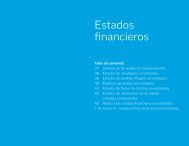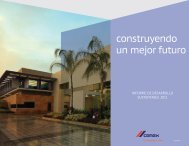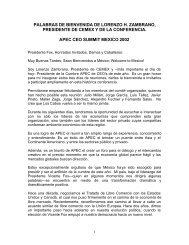building a STRONGER foundation - Cemex
building a STRONGER foundation - Cemex
building a STRONGER foundation - Cemex
Create successful ePaper yourself
Turn your PDF publications into a flip-book with our unique Google optimized e-Paper software.
CEMEX, S.A.B. DE C.V. AND SUBSIDIARIES<br />
Notes to the Consolidated Financial Statements – (Continued)<br />
As of December 31, 2010, 2009 and 2008<br />
(Millions of Mexican pesos)<br />
In the determination of whether it is more-likely-than-not that deferred tax assets will ultimately be realized, CEMEX takes into consideration<br />
all available positive and negative evidence, including factors such as market conditions, industry analysis, expansion plans, projected taxable<br />
income, carryforward periods, current tax structure, potential changes or adjustments in tax structure, tax planning strategies, future reversals<br />
of existing temporary differences, etc. Likewise, every reporting period, CEMEX analyzes its actual results versus the Company’s estimates,<br />
and adjusts, as necessary, its tax asset valuations. If actual results vary from CEMEX’s estimates, the deferred tax asset and/or valuations may<br />
be affected and necessary adjustments will be made based on relevant information. Any adjustments recorded will affect CEMEX’s income<br />
statement in such period.<br />
Based on changes in MFRS D-4 effective starting January 1, 2008, CEMEX reclassified the cumulative effect at December 31, 2007 for the<br />
initial recognition of deferred income taxes based on the assets and liabilities method from “Other equity reserves” to “Retained earnings”<br />
(note 16B). In addition, it was required to determine deferred income taxes for investments in associates. CEMEX recognized the cumulative<br />
initial effect as of January 1, 2008 against “Retained earnings.”<br />
In November 2009 reforms to the income tax law were approved in Mexico which became effective beginning January 1, 2010 (note 15A).<br />
These reforms include changes to the tax consolidation regime in Mexico pursuant to which entities are required, among other changes, to<br />
determine income taxes as if the tax consolidation provisions did not exist from 1999 and onward. In connection with this change in tax<br />
consolidation law, on December 15, 2009, CINIF issued for its immediate application MFRS Interpretation 18, “Effects on income taxes<br />
arising from the tax reform 2009” (“Interpretation 18”). Interpretation 18 establishes that the portion of the liability related to: a) the<br />
difference between the sum of the equity of the controlled entities for tax purposes and the equity of the consolidated entity for tax purposes;<br />
b) dividends from the controlled entities for tax purposes to CEMEX, S.A.B. de C.V.; and c) other transactions that represented the transfer of<br />
resources between the companies included in the tax consolidation, should be recognized against retained earnings. Moreover, Interpretation<br />
18 clarifies that the tax liabilities associated with the tax loss carryforwards used in the tax consolidation of the Mexican subsidiaries should<br />
not be offset with deferred tax assets in the balance sheet; therefore, beginning in 2009, CEMEX recognizes deferred income tax assets and<br />
liabilities associated with this concept separately. The realization of these tax assets is subject to the generation of future tax earnings in the<br />
controlled subsidiaries that generated the tax loss carryforwards in the past. In December 2010, by means of miscellaneous rules, the tax<br />
authority in Mexico eliminated the taxable amount for the difference between the sum of the equity of the controlled entities for tax purposes<br />
and the equity of the consolidated entity for tax purposes. Based on Interpretation 18, the effects from these modifications were recognized in<br />
2010 against “Retained earnings” (notes 15A and 16C).<br />
O) STOCKHOLDERS’ EQUITY<br />
Beginning in 2008, stockholders’ equity of the Parent Company would only be restated during high-inflation periods in Mexico.<br />
Common stock and additional paid-in capital (note 16A)<br />
These items represent the value of stockholders’ contributions, restated considering the Mexican inflation until December 31, 2007, including<br />
those increases related to the recapitalization of retained earnings and executive compensation (note 16).<br />
Other equity reserves (note 16B)<br />
This caption groups the cumulative effects of items and transactions that are, temporarily or permanently, recognized directly to stockholders’<br />
equity, and includes the elements of “Comprehensive income (loss) for the period,” which is presented in the statement of changes in<br />
stockholders’ equity. Comprehensive income includes, in addition to net income (loss), certain changes in stockholders’ equity during a<br />
period, not resulting from investments by owners and distributions to owners.<br />
The balance of “Other equity reserves” includes the result from holding non-monetary assets accrued until December 31, 2007, which<br />
referred to the difference between the revaluation effect of non-monetary assets (inventories, fixed assets, intangible assets) using specific<br />
restatement factors, and the effect that would have resulted using inflation-only restatement factors.<br />
The most significant items within “Other equity reserves” during the reported periods are as follows:<br />
Items of “Other equity reserves” included within comprehensive income for the period:<br />
Currency translation effects from the translation of foreign subsidiaries’ financial statements, net of changes in the estimated fair value<br />
of foreign currency forward contracts related to net investment in foreign subsidiaries (note 2K), and exchange results from foreign<br />
currency debt directly related to the acquisition of foreign subsidiaries, as well as from foreign currency related parties balances that are<br />
of a long-term investment nature (note 2D);<br />
The effective portion of the valuation and liquidation effects from derivative instruments under cash flow hedging relationships, which<br />
are recorded temporarily in stockholders’ equity (note 2K); and<br />
The deferred income tax arising from items whose effects are directly recognized in stockholders’ equity.<br />
F-15



